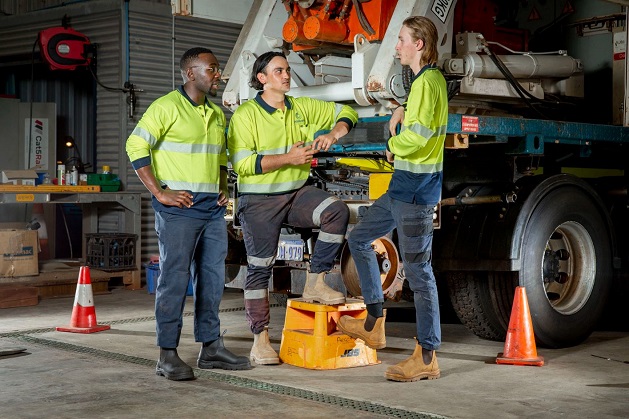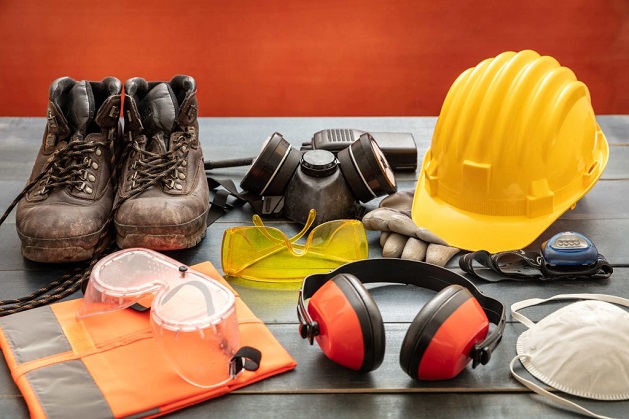In industrial environments, safety is paramount. Whether on a construction site, factory floor, or mining operation, wearing the right safety gear is essential for protection, comfort, and efficiency. Industrial workwear serves not just as a uniform but as a first line of defence against workplace hazards.
From head to toe, each component of protective gear plays a crucial role in safeguarding workers from accidents, injuries, and exposure to harmful substances. Among these elements, footwear stands out for its importance—and brands like Steel Blue have become a benchmark for reliability and comfort on the job.
The Requirements for Industrial Workwear
Regulations for industrial workwear and safety gear vary depending on the type of industry, workplace risks, and local laws. Compliance with the standards of the workplace ensures adequate protection against hazards like falling objects, chemical spills, and electrical risks. Employers are responsible for equipping workers with protective gear tailored to the job, while employees must ensure they use it correctly to stay safe and comfortable throughout the day.
Essential Safety Gear

1. Protective Clothing
Protective clothing is designed to shield workers from environmental hazards such as flames, chemicals, or sharp objects. Depending on the industry, this gear may include:
- Coveralls: Full-body protection from dust, dirt, and hazardous materials.
- Flame-resistant Clothing: Essential for workers in oil and gas industries.
- High-Visibility Vests and Jackets: Ensures workers are easily spotted in low-light conditions.
Benefits: Protects the skin from injuries, improves visibility, and ensures workers comply with safety protocols.
Footwear is a critical element in workplace safety, as the feet are often exposed to various hazards such as falling objects, sharp debris, slippery surfaces, and electrical risks. Proper safety footwear can significantly reduce the risk of injuries, enhancing overall worker safety and productivity.
This is why Steel Blue safety boots have gained recognition as a premier choice for industrial footwear. Due to their commitment to comfort, durability, and safety features, they are specifically designed for demanding work environments.
Key Features of Steel Blue Safety Shoes
- Steel Toe Caps:
Designed to protect against heavy impacts and crushing injuries, Steel Blue safety shoes feature robust steel toe caps that meet Australian and international safety standards. This protection is essential for workers in construction, manufacturing, and warehousing, where the risk of dropping heavy items is prevalent. - Slip-Resistant Soles:
Steel Blue safety shoes come with slip-resistant outsoles designed to provide excellent grip on various surfaces, including wet or oily floors. The specially engineered tread patterns minimise the risk of slips and falls, a leading cause of workplace injuries. - Electrical Hazard Protection:
Many models of Steel Blue safety boots are designed to offer electrical hazard protection. These boots are constructed with non-conductive materials to safeguard workers who may be exposed to electrical hazards, making them suitable for jobs in the electrical and construction sectors. - Durability and Waterproofing:
These shoes are made from high-quality leather that not only ensures durability but also provides water-resistant properties in many models. This makes them ideal for outdoor work environments where exposure to wet conditions is common, such as construction sites, landscaping, and agricultural tasks. - Custom Fit Options:
Comfort is key, and their safety shoes are often available in various widths and sizes. This range ensures that workers can find the right fit for their feet, further enhancing comfort and reducing the risk of foot-related injuries.
Benefits:
- Enhanced Safety: With features like steel toe caps, slip resistance, and electrical hazard protection, Steel Blue safety shoes provide comprehensive protection against common workplace hazards.
- Comfort: Their comfort technology ensures that workers can stay on their feet for extended periods without discomfort or fatigue, enhancing overall productivity.
- Versatile Designs: Available in various styles suitable for different industries, Steel Blue safety shoes can cater to the unique needs of workers across various sectors, from construction to manufacturing.
- Reputation for Quality: Steel Blue has established itself as a trusted brand in safety footwear, recognised for its commitment to quality and worker safety.
3. Head Protection
Hard hats and helmets are essential for protecting workers from head injuries caused by falling objects or accidental bumps. Depending on the workplace, additional features may include visors for eye protection or earmuffs to reduce noise exposure.
Use Cases:
- Hard Hats: Construction sites and manufacturing plants.
- Welding Helmets: Shielding from sparks and infrared radiation.
Benefits: Reduces the risk of head trauma and ensures workers meet safety standards.
4. Hand and Arm Protection
Hands are often exposed to sharp tools, heat, and hazardous substances. Gloves are essential to reduce the risk of injuries and ensure a firm grip when handling materials.
Types of Gloves:
- Cut-resistant gloves for handling sharp objects.
- Heat-resistant gloves for workers in welding or foundry jobs.
- Chemical-resistant gloves to prevent skin exposure to hazardous substances.
Benefits: Protects hands from injuries and ensures a comfortable and secure grip for handling tasks.
5. Respiratory Protection
In environments with airborne particles, chemicals, or fumes, respiratory protection is essential to prevent respiratory issues and long-term health risks.
- Respirators: Protect against dust, fumes, and harmful gases.
- Dust Masks: Useful in construction or woodworking environments.
Benefits: Shields workers from inhaling harmful substances, ensuring long-term respiratory health.
6. Eye Protection Gear
Workers exposed to flying debris, sparks, or chemicals need eye protection to prevent accidents. Safety goggles and face shields are essential, especially in industries such as welding, woodworking, and chemical manufacturing.
- Goggles: Provide a seal around the eyes for complete protection.
- Face Shields: Offer extended protection for the face and eyes.
Benefits: Reduces the risk of eye injuries, ensuring workers can perform tasks without obstructions or distractions.
How to Choose the Right Gear

- Assess Workplace Hazards: Identify potential risks such as falling objects, chemical spills, or slippery surfaces.
- Ensure Proper Fit and Comfort: Safety gear should fit snugly but not restrict movement. This is especially important for footwear—Steel Blue safety boots are known for their ergonomic design, ensuring maximum comfort during long shifts..
- Consider Job-Specific Needs: For instance, waterproof gear may be essential for outdoor workers, while flame-resistant clothing is crucial for those working in high-temperature environments.
Conclusion
Each piece of equipment plays a vital role in preventing workplace accidents and injuries. Choosing the right safety gear requires careful consideration of workplace hazards, fit, and compliance with regulations.
When workers are equipped with high-quality gear tailored to their environment, they can focus on their tasks with confidence, knowing they are protected from head to toe.


